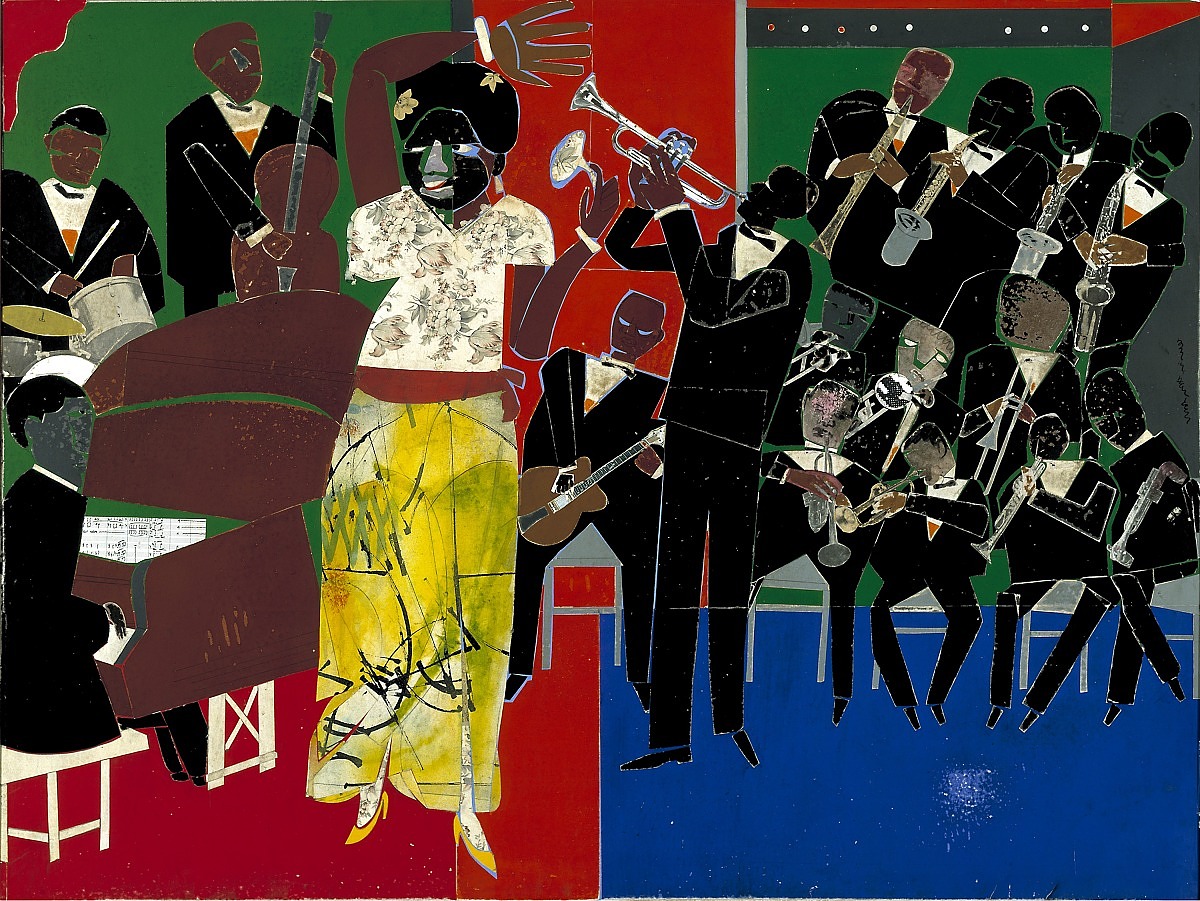Civil Rights and Artistic Expression: The Art of Romare Bearden
Expressing Community Change Through Collage
Overview and Context
Often lessons around civil rights focus on the actions of individuals (Harriet Tubman, Martin Luther King Jr., Rosa Parks, etc.) rather than teach from a community centered approach. Rarely do social, political, and cultural movements happen by individuals alone. It takes a critical mass of like-minded people working together in their local communities to create significant change. As a springboard into the Harlem Renaissance, this lesson compels students (upper elementary school age and above: 4th – 12th grade students) to think about their own communities by analyzing the collage art of Romare Bearden, culminating in the creation of a personalized collage piece. This lesson is easily accommodated because artistic expression of collage fosters inclusion of a wide range of skill levels.

Related California Standards
Grade 8 ELA:
- 1.9. Analysis and Evaluation of Oral and Media Communications: Interpret and evaluate the various ways in which visual image makers (e.g., graphic artists, illustrators, news photographers) communicate information and affect impressions and opinions. 11
- 3.7. Literary Criticism: Analyze a work of literature, showing how it reflects the heritage, traditions, attitudes, and beliefs of its author.
Learning Objectives
Students will:
- Reflect on what community means in their own lives.
- Analyze various works of art from the Harlem Renaissance (literature, poetry, music & visual art).
- Create a collage art about their own community inspired by the work of Romare Beardon.
- Understand the causes for the Great Northern Migration.
- Compare and contrast the freedoms & discrimination between southern and northern Black communities in the early 20th century.
Assessment
Students will write a reflection about their piece.
Materials and Resources
Materials
- Paper
- Wallpaper samples
- Paint
- Maps
- Newspaper
- Magazines
- Old calendars
- Glue
- Scissors
Online resources
- Romare Bearden video created by Jennifer Zee, September 2014
- Romare Bearden Foundation Collage Collection
- Harlem Renaissance Jazz playlist (one suggested playlist below)
Handouts
- Bearden Collage Analysis Worksheet Google Doc; Romare Bearden Collage Analysis PDF
- Copy of Student Community Collage Reflection Google Doc; Community Collage Reflection PDF
Step-by-Step Instructional Plan
Note that this plan is meant to take place over at least two class periods.
1. Quick-write
First, students will do a quick-write about community for a few minutes. What communities are you part of? How are these communities similar and different? What aspects of these communities do you like most? What are some challenges of being part of your different communities?
2. Resource Discussion and Activities
Then the following activities will take place:
- Discussion of Romare Bearden Video (10 minutes)
- Pair Share Activity using Bearden Collages Collection and Bearden Collage Analysis Worksheet
3. Art-Making
Next, students will move towards the Community Collage art activity, which can take anywhere from 60-120 minutes. Students will revisit their quick-write and decide on a community to express. Then they will draw a rough sketch of their idea and consider the following as they build their piece:
- Who will be represented?
- What objects will be included?
- Where will it take place?
- What activities?
- What colors will be most represented? Shapes? Textures?
Focusing on the background/setting, students explore and gather materials. Give each table group a stack of magazines & paper materials to get started, but also have material stations around the classroom where they can trade in materials for new ones. This is the time when you have let your students explore, chat, and share materials. Put on a Harlem Renaissance Jazz playlist (here is a suggestion) and encourage a creative classroom community. Allow students to paint, print, or marker paper to use in their collages. Other collage materials to collect and make available: greeting cards, maps, wrapping paper, and newspaper. Insist they create their design before gluing! Once the background/setting is made, students can start creating their community scene. Encourage students to include their own drawings into their collage. Because this may take a few class periods, provide envelopes in which students can keep their materials. Make sure students glue at the end!
4. Final Reflection
Finally, students will write the Community Collage Reflection
Accommodations
ELL/Below Grade Level: For written responses, teachers can allow for voice-to-text responses, shorter responses, extended time, or encourage students to draw pictures of their community.
Accelerated Learners: Open- ended prompts allow accelerated learners to expand their ideas.
Next Steps
Students can revise their written responses and collages based on teacher feedback.
Extensions and/or Enrichment
- Create tableaus based on their collages.
- Research another Harlem Renaissance artist.
Related Resources:
- Brown, Bryan. “The Harlem Renaissance.” The New York Times: Upfront, 30 Jan. 2023, pp. 18–21.
- The Romare Bearden Foundation (This site offers a wide range of resources and information on the art and life of preeminent African-American artist Romare Bearden.)

